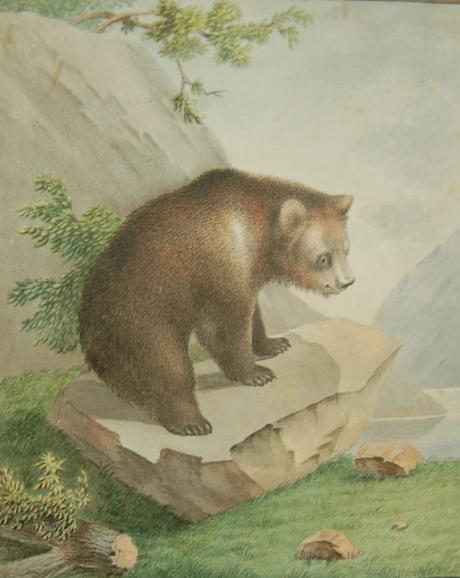The brown bear lives in the forests and mountains of northern North America, Europe, and Asia. It is the most widely distributed bear in the world. These omnivorous giants tend to be solitary animals, except for females and their cubs, but at times they do congregate. Dramatic gatherings can be seen at prime Alaskan fishing spots when the salmon swim upstream for summer spawning. In this season dozens of bears may gather to feast on the fish, craving fats that will sustain them through the long winter ahead. In fall a brown bear may eat as much as 90 pounds (40 kilograms) of food each day, and it may weigh twice as much before hibernation as it will in spring.
Brown bears dig dens for winter hibernation, often holing up in a suitable hillside. Females, or she-bears, den while pregnant and give birth during this winter rest, usually to a pair of cubs. Brown bear cubs nurse on their mother's milk until spring and stay with her for some two and a half years—so females only reproduce once every three years.Adult brown bears are powerful, top-of-the-food chain predators, but much of their diet consists of nuts, berries, fruit, leaves, and roots. Bears also eat other animals, from rodents to moose.The world's largest brown bears are found in coastal British Columbia and Alaska, and on islands such as Kodiak. Despite their enormous size, brown bears are extremely fast, having been clocked at speeds of 30 miles per hour (48 kilometers per hour). They can be dangerous to humans, particularly if surprised or if a person gets between a mother bear and her cubs.
Howitt, Samuel (1756/7–1823), painter and etcher, was the son of Thomas Howitt, attorney, of Hart Street, London, and his wife, Elizabeth, née Fleatham (1720/21–1797), daughter of Joshua Fleatham, a Quaker from Yarm, Yorkshire, who became a wealthy draper and glover on Cornhill, London. The traveller Francis Carter is thought to have been an uncle through his marriage to a sister of Elizabeth Fleatham. Howitt is first recorded as having a property at Chigwell, in Essex, and living as a gentleman of means—a keen sportsman, hunter, rider, and angler. A self-taught artist, he turned professional when financial difficulties forced him to earn a living. He drew on his enthusiasm and knowledge as a sportsman and produced sporting and natural history paintings, etchings, and illustrations. He sometimes worked in oils but more frequently in watercolours, and he was an accomplished etcher, signing his work ‘Howitt’ or ‘S. Howitt’, sometimes with the date. His earliest exhibits at the Incorporated Society of Artists, in 1783, were three ‘stained drawings’ of hunting scenes; he continued to exhibit, at the Royal Academy and elsewhere, until 1815. He also illustrated many sporting and zoological books, includingMiscellaneous Etchings of Animals (1803), Oriental Field Sports (1807), Aesop's Fables (1811), and The British Sportsman (1812). His watercolours and prints are represented in various collections, including the Victoria and Albert Museum, the British Museum, and the Tate collection.
Howitt married Elizabeth Rowlandson on 2 October 1779. They had three children—Elizabeth, William, and Maria—but had separated by the time that Howitt died. His wife was Thomas Rowlandson's sister, and Howitt and Rowlandson were friends as well as brothers-in-law. Howitt's early watercolour style has similarities to Rowlandson's, but Howitt developed a more individual style as his career as a sporting artist progressed. He seems to have had an innate capacity for drawing animals, from commonplace hare and deer to exotic species that he studied in menageries. He was an animated draughtsman, and his drawings of hunts and sporting events have a fluidity and excitement fitting to the subject.
Howitt was reputed to be somewhat unsteady and lively:
somewhat of a spoiled child—a wayward genius—of a congenial soul, and vivacious impulses, a trifle too given to yield to careless convivial company, or the allurements which the hour might hold forth, oblivious of sober consequences to follow. (Grego, 50)
He seems to have lived in London from 1793, apart from a short period when he gave an address as Richmond, Yorkshire. He returned to London, however, and lived and worked there until his death, at his home, 103 Chalton Street, Somers Town, between 9 February 1823, the date of his will, and his burial at St Pancras Old Church on 21 February.
Ruth Cohen DNB

